Heather Heffner's Blog, page 20
December 4, 2013
December Book Review: Happy Hour in Hell
HAPPY HOUR IN HELLBy Tad Williams~Book Review~
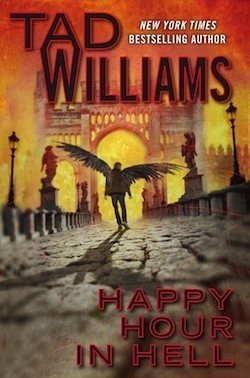
Warning! Spoilers!
BOBBY DOLLAR, a wise-cracking advocate angel, introduced us to his gritty afterlife in Book I: The Dirty Streets of Heaven . Bobby found floating around in blissful bureaucratic Heaven to be dreadfully boring compared to duking it out in the San Judas trenches over souls, courtroom-style. However, he got caught up with a missing soul mystery that attracted too much attention from Heaven andHell, and he began to wonder just how much of that heavenly bliss was to keep the majority pacified.
Casimira (Caz), the deadly Countless of Cold Hands, was a beautiful demon who helped Bobby investigate the missing soul case, and he might have fallen madly in love with her along the way. Although she was often described as looking “like a young schoolgirl” several times in the first book—(yuck)—she was a strong and interesting character. The last Bobby saw of her was when she was dragged back to Hell by her boss, the cruel Grand Duke Eligor, and now he’s determined to rescue her. Getting in won’t be easy. Getting out will be damn near impossible.
I couldn’t wait to get my hands on the second book in the series. As urban fantasy books gravitate toward fallen angels, heaven and hell, and the like, there have been a lot of Dante’s Inferno re-vamps or re-conceptions of the afterlife, some done not so well—Hadesby Alexandra Adornetto in which it was laughable—some done really well—The Space Between by Brenna Yovanoff in which her beautiful writing brought “Pandemonium” to life—or some choosing not to go there completely—Jessica Shirvington’s Violet Eden books, in which it’s hinted that heaven/hell aren’t like anything mortals know. I’ve also heard a lot about Thomas Sniegoski and look forward to reading his work. Dante’s Infernoand John Milton are key influences for my upcoming book, The Tribe of Ishmael, too, so I might…kinda sorta be REALLY interested!
That being said, what I really appreciate about Tad Williams (the well-known author of Memory, Sorrow and Thorn series) is the complexity he weaves into Bobby’s world. He doesn’t shy away from philosophical questions, there’s a lot the angels still don’t understand, and the atmospheric mystery keeps you flipping through the pages. The second book, Happy Hour in Hell , drops Bobby straight onto the Neronian Bridge as he sets off to find Caz. The Bridge grows longer, and longer, and Bobby runs out of funny little anecdotes to tell us as he wonders when he’ll actually get to Hell. Welcome to monotony.
This must have been a real difficult book to write. On one hand, the plot is rather straightforward, as Bobby must overcome all sorts of hellish obstacles and monsters on his way to Caz. Hell is organized along an elevator, in which the very bottom is an unspeakable place known only as the Prison of the Damned, and at the top is the lavish upper levels where the Grand Dukes and powerful demons live. The middle is where the majority of the book is spent with the “working-level” demons. I really liked how Bobby couldn’t even enter the lowest levels of Hell, because the pressure just built up too much inside of his head. It reminded me of diving too deep in the ocean. On the other hand, many of the villainous demon characters Bobby meets in Hell feel one-dimensional or not very engaging, and that slows the plot down. As readers, we often look for those humanizing characteristics that we can relate to in non-human characters. Sure, they can be twisted or messed-up, but as long as we can genuinely relate to them, we’ll follow that character anywhere. Otherwise, a monster…just feels like an imaginary monster. We begin to feel like the threat to the character’s life isn’t real. We begin not to care. Unfortunately, I began to feel that way throughout much of Happy Hour in Hell. Bobby’s allies, as few as they are, weren’t too memorable, and the minor villains came off as kind of cartoonish.
However, once Eligor and Caz show back up, so does the action. Eligor’s vileness works for me, and Caz, although relegated to a damsel-in-distress type role in this book, plays both sides well. Bobby makes some mistakes, but hey, he’s not an all-powerful angel, he’s just a middle guy who knows how to survive. His witty voice is written extraordinarily well, and he never pities himself for long, despite all of the horror and torture he goes through. I really liked how Williams portrayed Bobby’s latest assassin, Smyler, in this book. He was a cool Gollum-type of character.
In the end, I did feel an excited rush to see how Bobby would get out in time, and no detail is spared in the world-building of everyone’s favorite pit of suffering. Now the stage has been set for both Heaven and Hell, and as to what game Bobby’s angel superiors are playing promises a fantastic showdown in Book III: Sleeping Late on Judgment Day.
Recommended for fans of: Jim Butcher, Brandon Sanderson, Supernatural TV show fansJanuary Book Review: Wildefire by Karsten Knight

Warning! Spoilers!
BOBBY DOLLAR, a wise-cracking advocate angel, introduced us to his gritty afterlife in Book I: The Dirty Streets of Heaven . Bobby found floating around in blissful bureaucratic Heaven to be dreadfully boring compared to duking it out in the San Judas trenches over souls, courtroom-style. However, he got caught up with a missing soul mystery that attracted too much attention from Heaven andHell, and he began to wonder just how much of that heavenly bliss was to keep the majority pacified.
Casimira (Caz), the deadly Countless of Cold Hands, was a beautiful demon who helped Bobby investigate the missing soul case, and he might have fallen madly in love with her along the way. Although she was often described as looking “like a young schoolgirl” several times in the first book—(yuck)—she was a strong and interesting character. The last Bobby saw of her was when she was dragged back to Hell by her boss, the cruel Grand Duke Eligor, and now he’s determined to rescue her. Getting in won’t be easy. Getting out will be damn near impossible.
I couldn’t wait to get my hands on the second book in the series. As urban fantasy books gravitate toward fallen angels, heaven and hell, and the like, there have been a lot of Dante’s Inferno re-vamps or re-conceptions of the afterlife, some done not so well—Hadesby Alexandra Adornetto in which it was laughable—some done really well—The Space Between by Brenna Yovanoff in which her beautiful writing brought “Pandemonium” to life—or some choosing not to go there completely—Jessica Shirvington’s Violet Eden books, in which it’s hinted that heaven/hell aren’t like anything mortals know. I’ve also heard a lot about Thomas Sniegoski and look forward to reading his work. Dante’s Infernoand John Milton are key influences for my upcoming book, The Tribe of Ishmael, too, so I might…kinda sorta be REALLY interested!
That being said, what I really appreciate about Tad Williams (the well-known author of Memory, Sorrow and Thorn series) is the complexity he weaves into Bobby’s world. He doesn’t shy away from philosophical questions, there’s a lot the angels still don’t understand, and the atmospheric mystery keeps you flipping through the pages. The second book, Happy Hour in Hell , drops Bobby straight onto the Neronian Bridge as he sets off to find Caz. The Bridge grows longer, and longer, and Bobby runs out of funny little anecdotes to tell us as he wonders when he’ll actually get to Hell. Welcome to monotony.
This must have been a real difficult book to write. On one hand, the plot is rather straightforward, as Bobby must overcome all sorts of hellish obstacles and monsters on his way to Caz. Hell is organized along an elevator, in which the very bottom is an unspeakable place known only as the Prison of the Damned, and at the top is the lavish upper levels where the Grand Dukes and powerful demons live. The middle is where the majority of the book is spent with the “working-level” demons. I really liked how Bobby couldn’t even enter the lowest levels of Hell, because the pressure just built up too much inside of his head. It reminded me of diving too deep in the ocean. On the other hand, many of the villainous demon characters Bobby meets in Hell feel one-dimensional or not very engaging, and that slows the plot down. As readers, we often look for those humanizing characteristics that we can relate to in non-human characters. Sure, they can be twisted or messed-up, but as long as we can genuinely relate to them, we’ll follow that character anywhere. Otherwise, a monster…just feels like an imaginary monster. We begin to feel like the threat to the character’s life isn’t real. We begin not to care. Unfortunately, I began to feel that way throughout much of Happy Hour in Hell. Bobby’s allies, as few as they are, weren’t too memorable, and the minor villains came off as kind of cartoonish.
However, once Eligor and Caz show back up, so does the action. Eligor’s vileness works for me, and Caz, although relegated to a damsel-in-distress type role in this book, plays both sides well. Bobby makes some mistakes, but hey, he’s not an all-powerful angel, he’s just a middle guy who knows how to survive. His witty voice is written extraordinarily well, and he never pities himself for long, despite all of the horror and torture he goes through. I really liked how Williams portrayed Bobby’s latest assassin, Smyler, in this book. He was a cool Gollum-type of character.
In the end, I did feel an excited rush to see how Bobby would get out in time, and no detail is spared in the world-building of everyone’s favorite pit of suffering. Now the stage has been set for both Heaven and Hell, and as to what game Bobby’s angel superiors are playing promises a fantastic showdown in Book III: Sleeping Late on Judgment Day.
Recommended for fans of: Jim Butcher, Brandon Sanderson, Supernatural TV show fansJanuary Book Review: Wildefire by Karsten Knight
Published on December 04, 2013 16:25
December Book Review
HAPPY HOUR IN HELLBy Tad Williams~Book Review~

Warning! Spoilers!
BOBBY DOLLAR, a wise-cracking advocate angel, introduced us to his gritty afterlife in Book I: The Dirty Streets of Heaven . Bobby found floating around in blissful bureaucratic Heaven to be dreadfully boring compared to duking it out in the San Judas trenches over souls, courtroom-style. However, he got caught up with a missing soul mystery that attracted too much attention from Heaven andHell, and he began to wonder just how much of that heavenly bliss was to keep the majority pacified.
Casimira (Caz), the deadly Countless of Cold Hands, was a beautiful demon who helped Bobby investigate the missing soul case, and he might have fallen madly in love with her along the way. Although she was often described as looking “like a young schoolgirl” several times in the first book—(yuck)—she was a strong and interesting character. The last Bobby saw of her was when she was dragged back to Hell by her boss, the cruel Grand Duke Eligor, and now he’s determined to rescue her. Getting in won’t be easy. Getting out will be damn near impossible.
I couldn’t wait to get my hands on the second book in the series. As urban fantasy books gravitate toward fallen angels, heaven and hell, and the like, there have been a lot of Dante’s Inferno re-vamps or re-conceptions of the afterlife, some done not so well—Hadesby Alexandra Adornetto in which it was laughable—some done really well—The Space Between by Brenna Yovanoff in which her beautiful writing brought “Pandemonium” to life—or some choosing not to go there completely—Jessica Shirvington’s Violet Eden books, in which it’s hinted that heaven/hell aren’t like anything mortals know. I’ve also heard a lot about Thomas Sniegoski and look forward to reading his work. Dante’s Infernoand John Milton are key influences for my upcoming book, The Tribe of Ishmael, too, so I might…kinda sorta be REALLY interested!
That being said, what I really appreciate about Tad Williams (the well-known author of Memory, Sorrow and Thorn series) is the complexity he weaves into Bobby’s world. He doesn’t shy away from philosophical questions, there’s a lot the angels still don’t understand, and the atmospheric mystery keeps you flipping through the pages. The second book, Happy Hour in Hell , drops Bobby straight onto the Neronian Bridge as he sets off to find Caz. The Bridge grows longer, and longer, and Bobby runs out of funny little anecdotes to tell us as he wonders when he’ll actually get to Hell. Welcome to monotony.
This must have been a real difficult book to write. On one hand, the plot is rather straightforward, as Bobby must overcome all sorts of hellish obstacles and monsters on his way to Caz. Hell is organized along an elevator, in which the very bottom is an unspeakable place known only as the Prison of the Damned, and at the top is the lavish upper levels where the Grand Dukes and powerful demons live. The middle is where the majority of the book is spent with the “working-level” demons. I really liked how Bobby couldn’t even enter the lowest levels of Hell, because the pressure just built up too much inside of his head. It reminded me of diving too deep in the ocean. On the other hand, many of the villainous demon characters Bobby meets in Hell feel one-dimensional or not very engaging, and that slows the plot down. As readers, we often look for those humanizing characteristics that we can relate to in non-human characters. Sure, they can be twisted or messed-up, but as long as we can genuinely relate to them, we’ll follow that character anywhere. Otherwise, a monster…just feels like an imaginary monster. We begin to feel like the threat to the character’s life isn’t real. We begin not to care. Unfortunately, I began to feel that way throughout much of Happy Hour in Hell. Bobby’s allies, as few as they are, weren’t too memorable, and the minor villains came off as kind of cartoonish.
However, once Eligor and Caz show back up, so does the action. Eligor’s vileness works for me, and Caz, although relegated to a damsel-in-distress type role in this book, plays both sides well. Bobby makes some mistakes, but hey, he’s not an all-powerful angel, he’s just a middle guy who knows how to survive. His witty voice is written extraordinarily well, and he never pities himself for long, despite all of the horror and torture he goes through. I really liked how Williams portrayed Bobby’s latest assassin, Smyler, in this book. He was a cool Gollum-type of character.
In the end, I did feel an excited rush to see how Bobby would get out in time, and no detail is spared in the world-building of everyone’s favorite pit of suffering. Now the stage has been set for both Heaven and Hell, and as to what game Bobby’s angel superiors are playing promises a fantastic showdown in Book III: Sleeping Late on Judgment Day.
Recommended for fans of: Jim Butcher, Brandon Sanderson, Supernatural TV show fansJanuary Book Review: Wildefire by Karsten Knight

Warning! Spoilers!
BOBBY DOLLAR, a wise-cracking advocate angel, introduced us to his gritty afterlife in Book I: The Dirty Streets of Heaven . Bobby found floating around in blissful bureaucratic Heaven to be dreadfully boring compared to duking it out in the San Judas trenches over souls, courtroom-style. However, he got caught up with a missing soul mystery that attracted too much attention from Heaven andHell, and he began to wonder just how much of that heavenly bliss was to keep the majority pacified.
Casimira (Caz), the deadly Countless of Cold Hands, was a beautiful demon who helped Bobby investigate the missing soul case, and he might have fallen madly in love with her along the way. Although she was often described as looking “like a young schoolgirl” several times in the first book—(yuck)—she was a strong and interesting character. The last Bobby saw of her was when she was dragged back to Hell by her boss, the cruel Grand Duke Eligor, and now he’s determined to rescue her. Getting in won’t be easy. Getting out will be damn near impossible.
I couldn’t wait to get my hands on the second book in the series. As urban fantasy books gravitate toward fallen angels, heaven and hell, and the like, there have been a lot of Dante’s Inferno re-vamps or re-conceptions of the afterlife, some done not so well—Hadesby Alexandra Adornetto in which it was laughable—some done really well—The Space Between by Brenna Yovanoff in which her beautiful writing brought “Pandemonium” to life—or some choosing not to go there completely—Jessica Shirvington’s Violet Eden books, in which it’s hinted that heaven/hell aren’t like anything mortals know. I’ve also heard a lot about Thomas Sniegoski and look forward to reading his work. Dante’s Infernoand John Milton are key influences for my upcoming book, The Tribe of Ishmael, too, so I might…kinda sorta be REALLY interested!
That being said, what I really appreciate about Tad Williams (the well-known author of Memory, Sorrow and Thorn series) is the complexity he weaves into Bobby’s world. He doesn’t shy away from philosophical questions, there’s a lot the angels still don’t understand, and the atmospheric mystery keeps you flipping through the pages. The second book, Happy Hour in Hell , drops Bobby straight onto the Neronian Bridge as he sets off to find Caz. The Bridge grows longer, and longer, and Bobby runs out of funny little anecdotes to tell us as he wonders when he’ll actually get to Hell. Welcome to monotony.
This must have been a real difficult book to write. On one hand, the plot is rather straightforward, as Bobby must overcome all sorts of hellish obstacles and monsters on his way to Caz. Hell is organized along an elevator, in which the very bottom is an unspeakable place known only as the Prison of the Damned, and at the top is the lavish upper levels where the Grand Dukes and powerful demons live. The middle is where the majority of the book is spent with the “working-level” demons. I really liked how Bobby couldn’t even enter the lowest levels of Hell, because the pressure just built up too much inside of his head. It reminded me of diving too deep in the ocean. On the other hand, many of the villainous demon characters Bobby meets in Hell feel one-dimensional or not very engaging, and that slows the plot down. As readers, we often look for those humanizing characteristics that we can relate to in non-human characters. Sure, they can be twisted or messed-up, but as long as we can genuinely relate to them, we’ll follow that character anywhere. Otherwise, a monster…just feels like an imaginary monster. We begin to feel like the threat to the character’s life isn’t real. We begin not to care. Unfortunately, I began to feel that way throughout much of Happy Hour in Hell. Bobby’s allies, as few as they are, weren’t too memorable, and the minor villains came off as kind of cartoonish.
However, once Eligor and Caz show back up, so does the action. Eligor’s vileness works for me, and Caz, although relegated to a damsel-in-distress type role in this book, plays both sides well. Bobby makes some mistakes, but hey, he’s not an all-powerful angel, he’s just a middle guy who knows how to survive. His witty voice is written extraordinarily well, and he never pities himself for long, despite all of the horror and torture he goes through. I really liked how Williams portrayed Bobby’s latest assassin, Smyler, in this book. He was a cool Gollum-type of character.
In the end, I did feel an excited rush to see how Bobby would get out in time, and no detail is spared in the world-building of everyone’s favorite pit of suffering. Now the stage has been set for both Heaven and Hell, and as to what game Bobby’s angel superiors are playing promises a fantastic showdown in Book III: Sleeping Late on Judgment Day.
Recommended for fans of: Jim Butcher, Brandon Sanderson, Supernatural TV show fansJanuary Book Review: Wildefire by Karsten Knight
Published on December 04, 2013 16:25
November 28, 2013
The Tribe of Ishmael Teaser Trailer
Hi Everyone,
Happy Thanksgiving to all US readers! Here's a book trailer for my upcoming fantasy epic, Afterlife Chronicles I: THE TRIBE OF ISHMAEL, to celebrate:
Super specific about the release day, right? All I know for sure is it will be late December. Keep checking back, I'll post it here first :) Now, let the overindulgent feasting commence! Hope you can all be with your loved ones this year!
Happy Thanksgiving to all US readers! Here's a book trailer for my upcoming fantasy epic, Afterlife Chronicles I: THE TRIBE OF ISHMAEL, to celebrate:
Super specific about the release day, right? All I know for sure is it will be late December. Keep checking back, I'll post it here first :) Now, let the overindulgent feasting commence! Hope you can all be with your loved ones this year!
Published on November 28, 2013 12:50
November 26, 2013
Ebook Cover Design: Create Layers in Powerpoint
Tips for Indie Authors on creating your own book cover!
Create Layers
Under "Self-Publishing on Kindle," I recommend fellow author William King's method for creating an ebook cover in Powerpoint. Now here's some tips for creating layers in Powerpoint, if you have two or more images you'd like to combine.
1. Assemble the Pieces
Let's create a basic romance cover as an example. Here is a screenshot of my cover components laid out in Powerpoint. I have the title, genre, and author name laid out on the left. I have my background image of a romantic beach laid out in the middle. I have my overlaying image of a lovey-dovey couple on the right.
The Page Width and the images should be set to 6x8 width by height. Click on the "Design" tab on the top and then click on "Page Setup" on the ribbon to set the dimensions for Page Width. Right click on the picture and click "Size and Position" to set dimensions for images.

2. Set the Top Layer as Translucent
Now here's the fun part, where you can play around with your top image and how it looks. First, move the top image (lovey-dovey couple) over the background image (beach). Next, select the top image. Right-click on the top image. Scroll down the pop-up menu and select "Format Picture." In the Format Picture menu, select "3-D Format" from the column bar options. That will bring you to the screen shot shown below.

Here you notice the section called "Surface" under 3-D Format. Click on the "Material" drop-down arrow. You can now change the material to be "Translucent" so the the background beach image shows up underneath. Try it out! I selected the middle "Translucent" option under "Material." It's the middle of the three Translucent options. After the image turns translucent, notice that you can play around with the color/other image effects on the 3-D Format menu. For example, I clicked on "Lighting" and then selected the middle coloring option under "Warm." This makes the cover colors seem warmer and cozy. Play around with the different options under "Lighting." Notice how many different ways you can alter the image under "Angle," "Contour," and "Bevel," under the 3-D Format menu, in addition to all the other ways you can change image brightness/coloring/contrast/artistic effects on the regular Format ribbon!
3. Add Text

Now that your top image is translucent, add the text to the cover. Make sure you've right-clicked on each text box and chosen "Bring to Front." That way the text will be the top layer and won't get hidden behind the images. Drag all of your text boxes over and position them--and presto, you have a basically layered cover that screams, "I'm a romance!"
Photo Credit:
Lovely Couple © Fredgoldstein | Dreamstime Stock Photos & Stock Free Images
http://www.stockfreeimages.com/
Text Font Websites:
Obviously the color choice for the title may not be the best choice--yellow doesn't stand out well--but to amp up your creative font style to match the genre of your book, check out some of these websites for exciting font downloads (majority should be free):
1. http://www.dafont.com/
2. http://www.urbanfonts.com/free-fonts.htm
3. http://www.fontspace.com/
Published on November 26, 2013 13:56
November 5, 2013
November Book Review
SHADOW AND BONE By Leigh Bardugo~Book Review~
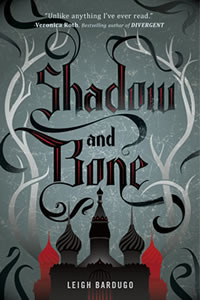 Warning! Minor Spoilers!
Warning! Minor Spoilers! I AM A SUCKER for a good villain.
Shadow and Bone is a fantasy YA novel, but the ambiguous character of the Darkling, the powerful leader of the sorcerous Grisha, manages to be complex on so many levels that I just wanted to shake him and yell: “Tell me your secrets!”
He is probably the chief reason you should read this book. Although I really loved the introduction to main characters Alina and her handsome friend Mal, orphans who live a tough life growing up along the monstrous Fold, the book lost its momentum when Alina was sent to the Ravka palace. Some time is spent developing her “Sun Summoner” powers, an ability to call light that could end the nightmarish Fold cutting Ravka off from the rest of the world, but more is spent judging her fellow females and lamenting her plainness. Insecurity is a hard line for authors to walk when it consumes their main character—it’s tough to make it relatable rather than descend into a pity fest—and I feel like it fell into the latter category for most of the book.
Much of the mythology and world-building was inspired by Russian folklore, and there were a lot of places it worked well, like with the symbolism of the stag. Other parts, like the Russian-inspired language, didn’t seem to transfer over as well—as others have pointed out, Alina’s family name is “Starkov” rather than the feminine form, “Starkova.” Starkova sounds prettier, too, *sigh*.
I did like Alina’s relationship with Mal and feel that the regiment-minded Mal has a lot of potential—I hope he doesn’t become just a love interest, but has an agenda of his own. I also enjoyed how the Darkling made Alina wrestle with her choices of right or wrong, and the final unraveling of their relationship left me breathless with excitement for what is to come.
Alina did develop more of a backbone by the end of the book, and just the thought of the elemental-wielding Grisha in action makes me happy, so I am eager to get my hands on Book II: Seige and Storm .
Recommended for fans of: Sophie Jordan, Rae CarsonDecember Book Review: Happy Hour in Hell by Tad Williams
Published on November 05, 2013 16:27
October 29, 2013
Year of the Tiger Published on Smashwords!
Year of the Tiger
, Book II in the Changeling Sisters Series, is now available through Smashwords.com, which offers PDF/Sony/EPUB/Online Reading Formats! Happy Halloween, everyone!
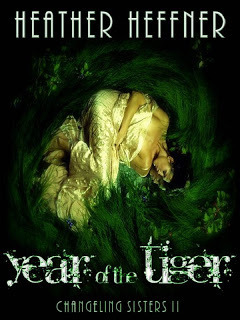

Published on October 29, 2013 16:23
October 4, 2013
US Government Shutdown: Reflections
THE DAY AFTER the government shutdown in October, I went to my work. We commenced to have a lively discussion lamenting the following things:
John BoehnerThe gerrymandering of districts by both parties so no Congressional seats can ever be truly contestedThe inexplicable phenomena of the Tea Party having so much power in the Republican PartyJohn Boehner and other politicians’ “me-first” leadership (influenced no doubt by the media and its constant quips on how if Boehner calls for a vote, then "he's surrendering!")How the US government shutdown may be part of our larger decline in the eyes of the worldWhat this gradual accumulation of wealth in a smaller and smaller percentage of people at the top without being re-distributed means for capitalism (and for our daily lives)The Legislature’s non-actions being like if the Executive said, “I’m not going to do anything until you pass gun control"And John Boehner. Seriously, Boehner, just call a vote in the House already.
It got dark and depressing as usual. Yay for gridlocked democracy.
After work, I took my forty-minute bus ride back home. I sat next to a talker: an older man of Japanese descent who’d been born and raised here on Oahu. He started asking if I was going to school here, what I was studying, and he gradually coaxed me into conversation. Naturally, the topic swayed toward politics and everything that was going wrong, and I was surprised when he kept up with me. Contemporary issue for contemporary issue. And I had to recognize my own egalitarian bias, that an everyday guy on the street would know as much as me if not more about the pitfalls of our current system. But I’m young and think I know everything.
We talked about a lot of things. The grandfather pointed out that Hawai’i reflects the shift of cultural values that the rest of the mainland is *now* experiencing with the influx of South American and Asian immigrants. While the mainland (Tea Party) is struggling to comprehend that the “norm” isn’t Puritanical white values infused with the old “pioneer spirit/manifest destiny” anymore (hasn’t been for some time)—the landscape has shifted—Hawai’i has known this for a long time. Things here obviously aren’t perfect. There’s racism as people of different cultural values negotiate living together and there’s the real danger of the Hawaiian language disappearing forever. But people have had more time to see that these different narratives can intertwine together while not losing what makes them different.
In Washington, when I’d watch the news, a good chunk of it would be spent on violence and who’d been murdered in yet another shooting spree. On Oahu, the local news will struggle to find some crime to report—but eventually they’ll just end up talking about a cute cat that ended up stuck in a tree. When there is a murder, it is shocking and sad to the entire community, and you can hear the loss in the reporter’s voice.
“I think everyone should be required to go live somewhere else for a while. Go abroad. People here are so spoiled. In America, it’s all about the convenience. Nowhere else in the world do you find the convenience we have,” the grandfather said, listing off all the places he’d been to—Japan, Thailand, Vietnam, a number of countries in Europe.
Smart guy. If there were a way to make that possible, then that would be the most awesome thing ever.
“But I love America. Greatest country in the world!” he exclaimed, as his bus stop came up. “Other nationalities may criticize America. But you give them a ticket to come here, and they’d be on the first plane over.”
I think there's some truth to that. There is something about the promise of America that is still being realized even by the people who’ve lived here our whole lives. I’d been beginning to lose my faith in the democracy we have, but this random stranger knew that even with all of its ugliness, we can’t give up on it yet.
Disclaimer: The above is depicted as fiction, not fact.
Published on October 04, 2013 16:10
October 3, 2013
October Book Review: Daughter of Smoke and Bone
DAUGHTER OF SMOKE AND BONE By Laini Taylor~Book Review~
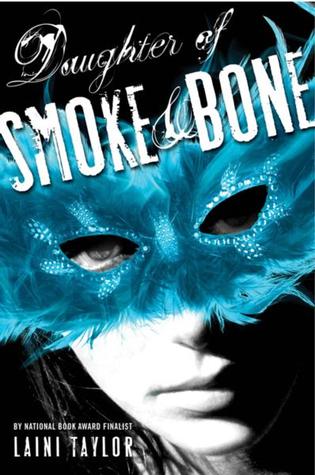
Warning! Spoiler Alert!
LYRICAL, HAUNTINGLY ROMANTIC, with enough beautiful turns of phrase to make me squeal with glee.
Yes, I had a fun time reading this book .
Meet Karou, a blue-haired bundle of awesomeness who is an art student in Prague by day and a teeth-collector for the mysterious Brimstone by night. Come, now. You know you’re intrigued, if not a little bit creeped-out by, that “teeth-collector” bit. But it’s just one of the many ways Laini Taylor subverts typical tropes of YA fantasy. While she’s not off exploring an atmospheric Prague with her snarky ballerina friend Zuzanna, Karou goes on “errands” for her mentors, a trio of eccentric devils with a secret agenda that is attracting otherworldly attention.
Karou’s “family” are original, well-defined characters who never fail to enchant in every scene they’re featured in. Since the family is introduced as “demons,” the reader immediately questions whether we can trust their motivations or not—especially since they’re asking Karou to steal teeth of all things from a variety of species, humans not excluded, for God knows what purpose. I loved imagining the chimera-like appearance of the demon leader, the wise old Brimstone, and the scaly serpent Issa. Vaguely sinister or not, I was rapt with attention to figure out what this demonic family was up to.
Of course, when the angels showed up—the vengeful fiery kind that leaves smoldering black handprints on the homes of the demons as a warning of ill tidings to come—Karou’s family gets cast in a more sympathetic light. And Karou is left more in doubt than ever of who she “was” and what horrific secret her family is hiding from her.
Okay, so I really enjoyed the first half of the book. I was truly content watching this intricate world-building take place. The little things—like the hole-in-the-wall Bohemian restaurant Karou and Zuzanna gossip in, the timeless feel of the colorful streets of Prague, the revenge on Karou’s supremely entertaining ex-lover, Kazimir, whisked me away to a trance-like state of bliss. Karou was organic, independent and smart, an instant favorite fantasy heroine like my others—Katniss, Hermoine Granger, Rose Hathaway—and I absolutely loved the ugliness of Razgut, a fallen angel who’s so self-righteously selfish and grotesque to read about, you can’t help but want more.
The romantic lead, Akiva the angel, is okay. He’s blindly following the angelic cause, but questions all the right things, and seems like a decent guy. He failed to entrance me the way he does Karou, but then again, so did the entire second half of the book. It launches an entirely different plot from the first part, exploring Karou’s past life. I really didn’t see that coming. And while the doomed love story between Akiva and Karou, aka, “Madrigal” is conventionally dramatic and wrestles with some dark, depressing themes—genocide and exploitation—the entire time I was thinking, “When are we gonna get back to Prague?” I suppose I feel that less time could have been spent on the flashback. Taylor got me so invested in the present-day characters and their present-day troubles that I was impatient having to wade through a long, drawn-out back story. By the time I was finally returned to the present, the urgency was gone. I couldn’t remember the dire circumstances we’d left our main character off in. Cue cliffhanger.
Ah, well. Kudos to Taylor for making her magical version of Prague feel more fantastical than the actual fantasy flashback world. And from what my preview of Book II: Days of Blood and Starlight suggests, at least Zuzanna, Kazimir, and the rest of the gang back in Prague won’t be forgotten. Definitely recommend investing in this beautiful series—it reads like a modern-day fairytale.
Recommended for Fans of: Ursula K. LeGuin, Patricia A. McKillip, Robin Hobb, Guy Gavriel KayUpcoming October Book Review: Shadow and Bone by Leigh Bardugo
Published on October 03, 2013 18:40
September 24, 2013
The Tribe of Ishmael Book Cover
Published on September 24, 2013 15:14
September 17, 2013
Walking along the DMZ 한반도 비무장지대
In 1953, the Korean War ended with an armistice. Not a peace treaty. As such, North and South Korea remain divided at the 38th parallel by a line decided with *much* input from Cold War enemies China and the US--the Demilitarized Zone (DMZ). It spans a length of 160 miles and is approximately 2.5 miles wide of land mines, wilderness, and a surprising number of endangered species.
Today, the DMZ remains heavily patrolled. Soldiers on both sides watch for suspicious activity, South Korea remembering when they found evidence of the North Korean-dug tunnel in 1990. The 6-Party Talks dedicated to the denuclearization of the Korean Peninsula hang in limbo, the financial realities of an eventual reunion cast hesitation on the South Korean side, and Dennis Rodman continues to be the most frequent American visitor to North Korean dictator Kim Jong-un, wielding the formidable likes of "basketball diplomacy."
Will this sign at the northernmost Dorasan Train Station continue to be an empty gesture?

Separated families on either side certainly hope not, and so do the thousands of refugees who flee through China every year, where they must really know who to trust, or else they will be sent back to North Korea due to their "illegal immigrant" status. The current administrations of North and South Korea continue to hold working level talks about co-run ventures. The jointly sponsored Kaesong Industrial Complex, which was nearly shut down over the summer, has recently rebounded and resumed operations on 9-16. The first family reunion in three years is planned for Sept. 25-30th. So the story continues in its up and down pattern, with the US, Japan, China, and Russia watching at every turn the course of two small nations on a very strategically located peninsula.
Naturally, tourists flock to the infamous DMZ, and I was among them. Normally I do tours with Seoul Hiking Group, which in addition to affordable hiking trips, also offers tours to Jeju Island, Ginseng Festivals, rafting locales, and featured biking excursions, but this time I decided to try out Adventure Korea . They offered a one-day tour of the DMZ for 43,000 won that included a bus pick-up from Hongik University Station (홍대입구역/Hangeul Pronunciation: Hongdae Ipgu Yeok). Identification is *required* to pass the Civilian Control Line, and for foreigners that means a passport or Alien Registration Card.
My fellow Foreign English teacher friends couldn't make it for the August trip, but I made some new friends on the bus ride over, one of whom worked in a hagwon for her aunt, and another who taught in West Seoul. We kicked off the tour by visiting Imjingak, the northernmost village civilians can freely visit before having to provide identification. Our tour guide knew a guy there who sold North Korean money to tourists and was most likely making a nice profit off of it, too, but hey, I was curious. Our guide continued to be full of interesting stories on the ride up to the Civilian Control Line--he remembered fondly the old days when tours were still allowed to enter border villages of North Korea and have a couple drinks with the locals.
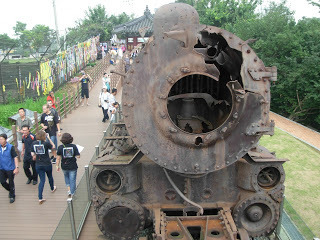
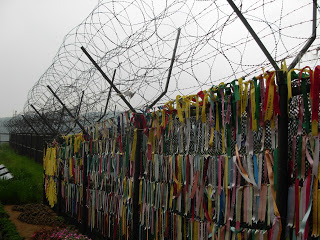
At the Civilian Control Line, we registered to cross over into Tongilchon, a Unification Village. Soldiers walked upon and down the bus and examined each of our IDs. Then we were settled in a farmhouse in a rather empty-looking village for a lunch of a miyeok guk (seaweed soup), tangpyeongchae (jelly noodles and veggies), kimchi, and various other side dishes. The South Koreans living in the village inhabit a Tax Free Zone/exempt from 2-year service in the army because of their proximity to the DMZ, but they do have to follow various government regulations when exporting crops over the Line.
From there, we arrived at the cavernous mouth down to the 1978 North Korean-dug infiltration tunnel. Wearing hard hats, we descended deep into the earth and walked past rubber mats and remnant mining equipment before laying eyes on the discovered tunnel, 239 feet under the earth (app. 73 meters). Our guide informed us that it would have allowed some 10,000 soldiers to reach Seoul within one hour.
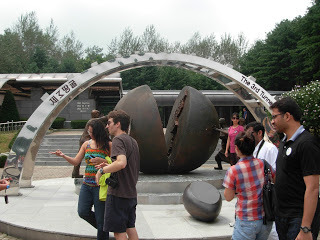
I ran into some trouble at the next stop, the Dora Observatory. It overlooks the vast expanse of the DMZ, much of it hidden behind cloud cover. Unfortunately, I misunderstood my guide's explanation about where to take pictures and where not to, and a South Korean soldier politely informed me that I was not supposed to photograph Kijongdong, a North Korean propaganda village that features an insanely tall flag pole, built to make sure it overshadowed South Korea's flag. Aside from a couple supply trucks far off in the haze, the green expanse of the DMZ appeared eerily still. I deleted my photographs under the soldier's supervision.
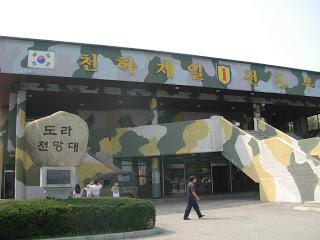 Dora Observatory
Dora Observatory
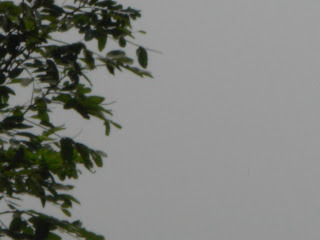 Aaaand there's your picture of North Korea. Hey, if you squint you can see a mountain. Soldier ok-ed this one.
Aaaand there's your picture of North Korea. Hey, if you squint you can see a mountain. Soldier ok-ed this one.
The last stop on the tour was Dorasan Train Station, meant to give some semblance of hope, I suppose, because of its emphasis that one day it would connect back to North Korea. Peoples' spirits lifted while exploring the train station, and the long-suffering soldiers posted around the platform agreed to be photographed with many of us. We could also purchase a symbolic ticket embarked with a seal for about 1,000 won (1 dollar). We goofed around the silent platform for a little bit and then boarded the bus back to Seoul, leaving the empty station with its motionless turnstiles and patiently waiting trains behind.

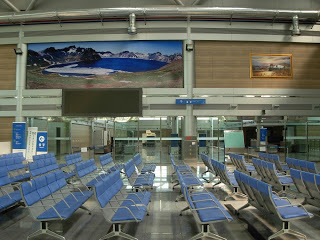
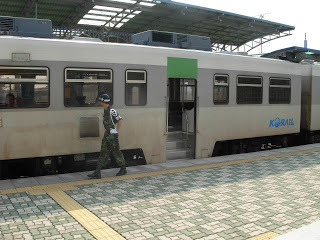
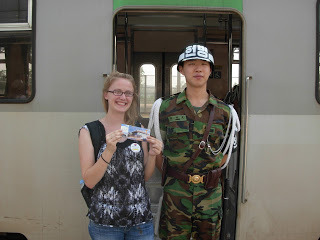 You know he was bored.
You know he was bored.

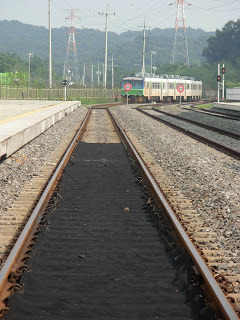
*Disclaimer: The above is depicted as fiction, not fact.
Today, the DMZ remains heavily patrolled. Soldiers on both sides watch for suspicious activity, South Korea remembering when they found evidence of the North Korean-dug tunnel in 1990. The 6-Party Talks dedicated to the denuclearization of the Korean Peninsula hang in limbo, the financial realities of an eventual reunion cast hesitation on the South Korean side, and Dennis Rodman continues to be the most frequent American visitor to North Korean dictator Kim Jong-un, wielding the formidable likes of "basketball diplomacy."
Will this sign at the northernmost Dorasan Train Station continue to be an empty gesture?

Separated families on either side certainly hope not, and so do the thousands of refugees who flee through China every year, where they must really know who to trust, or else they will be sent back to North Korea due to their "illegal immigrant" status. The current administrations of North and South Korea continue to hold working level talks about co-run ventures. The jointly sponsored Kaesong Industrial Complex, which was nearly shut down over the summer, has recently rebounded and resumed operations on 9-16. The first family reunion in three years is planned for Sept. 25-30th. So the story continues in its up and down pattern, with the US, Japan, China, and Russia watching at every turn the course of two small nations on a very strategically located peninsula.
Naturally, tourists flock to the infamous DMZ, and I was among them. Normally I do tours with Seoul Hiking Group, which in addition to affordable hiking trips, also offers tours to Jeju Island, Ginseng Festivals, rafting locales, and featured biking excursions, but this time I decided to try out Adventure Korea . They offered a one-day tour of the DMZ for 43,000 won that included a bus pick-up from Hongik University Station (홍대입구역/Hangeul Pronunciation: Hongdae Ipgu Yeok). Identification is *required* to pass the Civilian Control Line, and for foreigners that means a passport or Alien Registration Card.
My fellow Foreign English teacher friends couldn't make it for the August trip, but I made some new friends on the bus ride over, one of whom worked in a hagwon for her aunt, and another who taught in West Seoul. We kicked off the tour by visiting Imjingak, the northernmost village civilians can freely visit before having to provide identification. Our tour guide knew a guy there who sold North Korean money to tourists and was most likely making a nice profit off of it, too, but hey, I was curious. Our guide continued to be full of interesting stories on the ride up to the Civilian Control Line--he remembered fondly the old days when tours were still allowed to enter border villages of North Korea and have a couple drinks with the locals.


At the Civilian Control Line, we registered to cross over into Tongilchon, a Unification Village. Soldiers walked upon and down the bus and examined each of our IDs. Then we were settled in a farmhouse in a rather empty-looking village for a lunch of a miyeok guk (seaweed soup), tangpyeongchae (jelly noodles and veggies), kimchi, and various other side dishes. The South Koreans living in the village inhabit a Tax Free Zone/exempt from 2-year service in the army because of their proximity to the DMZ, but they do have to follow various government regulations when exporting crops over the Line.
From there, we arrived at the cavernous mouth down to the 1978 North Korean-dug infiltration tunnel. Wearing hard hats, we descended deep into the earth and walked past rubber mats and remnant mining equipment before laying eyes on the discovered tunnel, 239 feet under the earth (app. 73 meters). Our guide informed us that it would have allowed some 10,000 soldiers to reach Seoul within one hour.

I ran into some trouble at the next stop, the Dora Observatory. It overlooks the vast expanse of the DMZ, much of it hidden behind cloud cover. Unfortunately, I misunderstood my guide's explanation about where to take pictures and where not to, and a South Korean soldier politely informed me that I was not supposed to photograph Kijongdong, a North Korean propaganda village that features an insanely tall flag pole, built to make sure it overshadowed South Korea's flag. Aside from a couple supply trucks far off in the haze, the green expanse of the DMZ appeared eerily still. I deleted my photographs under the soldier's supervision.
 Dora Observatory
Dora Observatory
 Aaaand there's your picture of North Korea. Hey, if you squint you can see a mountain. Soldier ok-ed this one.
Aaaand there's your picture of North Korea. Hey, if you squint you can see a mountain. Soldier ok-ed this one.The last stop on the tour was Dorasan Train Station, meant to give some semblance of hope, I suppose, because of its emphasis that one day it would connect back to North Korea. Peoples' spirits lifted while exploring the train station, and the long-suffering soldiers posted around the platform agreed to be photographed with many of us. We could also purchase a symbolic ticket embarked with a seal for about 1,000 won (1 dollar). We goofed around the silent platform for a little bit and then boarded the bus back to Seoul, leaving the empty station with its motionless turnstiles and patiently waiting trains behind.



 You know he was bored.
You know he was bored.

*Disclaimer: The above is depicted as fiction, not fact.
Published on September 17, 2013 16:35




